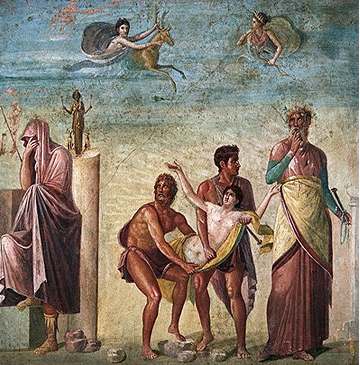Emilia Galotti: Ein Trauerspeil in Funf Aufzugen by Gotthold Ephraim Lessing, an influential early German Romantic work (a copy of it lies open beside the hero of Goethe's Young Werther when he commits suicide) and adaptation of John Webster's Appius and Virginia, was first drafted in 1758 and revised in 1767-1770, finally debuting on stage in 1772. Lessing is believed by critics to have been influenced by the 1750 Spanish tragedy Virginia by Don Agustín Gabriel de Montiano y Luyando, which he read in the French translation of 1754. Emilia Galotti is considered Lessing's most mature work and a major statement of his dramatic ethos. It was a critique of tyrannical princes, yet Emilia's response to the prince's advances is ambiguous and the play emphasizes the domestic tragedy, including a mother, Claudia, for Lessing's "burgerliche Virginia." While Montiano's Virginia chooses for herself whether or not to inform her father and fiance of her danger, Emilia herself (like Webster's Virginia) instigates her death, ordering her father to kill her rather than let her suffer moral degradation in an affair with the Prince.
Emilia Galotti also contains references to Lessing's most important critical work (above, an American edition with the Agesander marble), Laokoon oder über die Grenzen der Mahlerey und Poesie (Laocoon, or, On the Limits of Painting and Poetry, 1766), which discusses the classical precept "ut pictura poesis."
In Laokoon, Lessing, as a playwright, critic, and probably the first dramaturg, called for a return to the Aristotelian precepts of the drama and Shakespearean models, like Seneca and Webster, rather than the French tradition that was popular at the time. Emilia Galotti opens as the Prince receives from his court painter new portraits, one of his previous mistress and one of his new interest, young Emilia.
Shakespeare's Hermione from A Winter's Tale similarly is cast in a statue and later resurrected, as is the duchess of Malfi in Lewis Theobald's adaptation The Fatal Secret. Tamora from Taymor's Titus appears in tableaux with her sons, part of what Taymor calls "Penny Arcade Nightmares" from the tradition of melodrama. Taymor's translation of the literal stage architecture used for her theatrical performances onto film resulted in highly stylized scenes.
Lessing argues in Laokoon that a painting and a play, as different genres, use different techniques; it is false or unnecessary for a dramatic tragedy to attempt to paint a picture with literal descriptions and symbolic objects that evoke metaphorical associations, as painting or sculpture must capture an eternal, fixed, unchanging moment (the "pregnant moment") that can truly encompass the whole story. Rather, a play should evoke emotion by its own, classical methods to produce the illusion of reality: the performance of the actor, the resonance of the dialogue, the nobility of a character, the pity of the audience, etc.
Lessing says of a classical painting (above) depicting the sacrifice of Iphigenia: "he [Timanthes, the artist] gives to the countenance of every spectator a fitting degree of sadness, but veils the face of the father, on which should have been depicted the most intense suffering . . . He knew that the grief befitting Agamemnon, as a father, produces contortions which are essentially ugly" (Laokoon 12-13).
Similarly, plays use paintings, statues, and tableaux in ways often misleading or false. The objectification of women in statues, paintings, and tableaux seems to be strong and literal, but it is actually misleading, just as Taymor's Tamora uses the tableaux to deceive Titus.
"Whoever requires a beautiful picture has missed the whole intention of the poet" (Laokoon 21).
This architectural metaphor invokes anxieties of deceit and instability: a monument is no guarantee of memory.



No comments:
Post a Comment